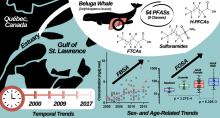| Title | Trophic transfer of dechloranes in the marine food web of Liaodong Bay, north China. |
| Publication Type | Journal Article |
| Year of Publication | 2014 |
| Authors | Peng, H, Wan, Y, Zhang, K, Sun, J, Hu, J |
| Journal | Environ Sci Technol |
| Volume | 48 |
| Issue | 10 |
| Pagination | 5458-66 |
| Date Published | 2014 May 20 |
| ISSN | 1520-5851 |
| Keywords | Animals, Aquatic Organisms, Bays, Charadriiformes, China, Environmental Monitoring, Fishes, Food Chain, Geologic Sediments, Hydrocarbons, Chlorinated, Invertebrates, Ontario, Regression Analysis, Water Pollutants, Chemical |
| Abstract | Dechloranes are of particular concern because of their ubiquity in environmental matrices, but little is known about their trophic transfer in aquatic food web. This study investigated the trophic transfer of seven dechloranes in a marine food web from Liaodong Bay, China. Dechloranes were determined in sediments and 15 marine species including benthic invertebrates, fish and gulls collected from Liaodong Bay. Biomagnification factors (BMFTL) of dechloranes in black-headed gulls were calculated to be 6.4, 1.7, 0.45, 0.36, 0.14, and 0.11 for mirex, Dechlorane 602 (Dec 602), Dechlorane 603 (Dec 603), antiundecachloropentacyclooctadecadiene (anti-Cl11DP), syn-dechlorane plus (syn-DP), and anti-DP. Significantly positive relationships were found between lipid equivalent concentrations of mirex, Dec 602, and anti-Cl11DP and trophic levels, and the trophic magnification factors (TMFs) were 13, 3.7, and 5.6, respectively, indicating that these compounds undergo trophic magnification in the aquatic food web. Lipid equivalent concentrations of Dec 603 and DP isomers did not exhibit a statistically significant correlation with trophic levels. The relatively low trophic magnification potentials of Dec 603 and DP isomers were possibly due to their extreme hydrophobicity (logKOW: 11.2-11.3) and subsequent low bioavailabilities compared with mirex (7.0), Dec 602 (8.1) and anti-Cl11DP. The results provided important information for understanding the ecological risk of dechloranes. |
| DOI | 10.1021/es500229y |
| Alternate Journal | Environ. Sci. Technol. |
| PubMed ID | 24702310 |
Environmental Chemical Biology

